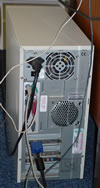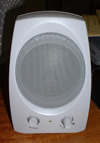![[East Midlands Oral History Archive logo]](../../images/logo.gif) |
Computer |
||
|
|
|||
Recording with your computer (1)
Another option is recording directly onto the hard drive of a laptop computer or PC. To do this you will need a microphone, suitable software, and soundcard. You can find out more about this by looking at EMOHA Information Sheet No 18: Digitising Oral History.
The biggest advantage of recording oral history directly onto a computer is that you are then able to edit it straight away. However, before you start recording all of your interviews directly onto your computer, some words of warning:
- A computer may emit a lot of noise. It is vital to use an external mic and to place it as far away from the computer as possible.
- Computers crash. How will you feel if you have been conducting a three hour interview and your computer crashes as you get to the end and all of your interview is lost? Make sure you save chunks of the interview whenever possible.
- Keep an unedited copy. It is important to keep an archive copy of the entire interview warts and all. If you then edit the sound to take out mistakes, pauses, boring bits or anything else you are creating a new version of the interview. Keep records of any editing you have done.
- Backup. Make copies on a portable hard drive or use CDs or DVDs.
In order to record sound onto a computer you will need: a computer, a sound card, speakers (see the pictures to the right), and the appropriate software. Find out more about what software to use.
A soundcard fits in the computer 'stack' or 'tower' (top picture). The inputs at the back are likely to be green, pink and blue (centre picture) and you plug your minidisk/cassette/CD player into one of the inputs (probably the blue one), your speakers in other (probably the green one) and your microphone into the third (probably the pink one). You will need a minijack connector to connect to these inputs. More about connections.

To record using your computer you will have to be prepared to look at
the back of the machine.

The soundcard on the back of your computer will look something like this

You will also need to connect a speaker like this one to your computer
to be able to hear anything. Some computers (especially laptops) may have
speakers built in, but, just because your computer "pings" at
you from time to time, doesn't mean that it has a soundcard and speakers.
|
|
|
![[search]](../../images/buttons/search.gif)
![[Hosted by the University of Leicester]](http://www.le.ac.uk/corporateid/navigation/hostedby.gif)
![[University Home]](http://www.le.ac.uk/corporateid/navigation/unihome.gif)
![[EMOHA Homepage]](http://www.le.ac.uk/corporateid/navigation/archive.gif)
![[contact the East Midland Oral History Project]](http://www.le.ac.uk/corporateid/navigation/contact.gif)